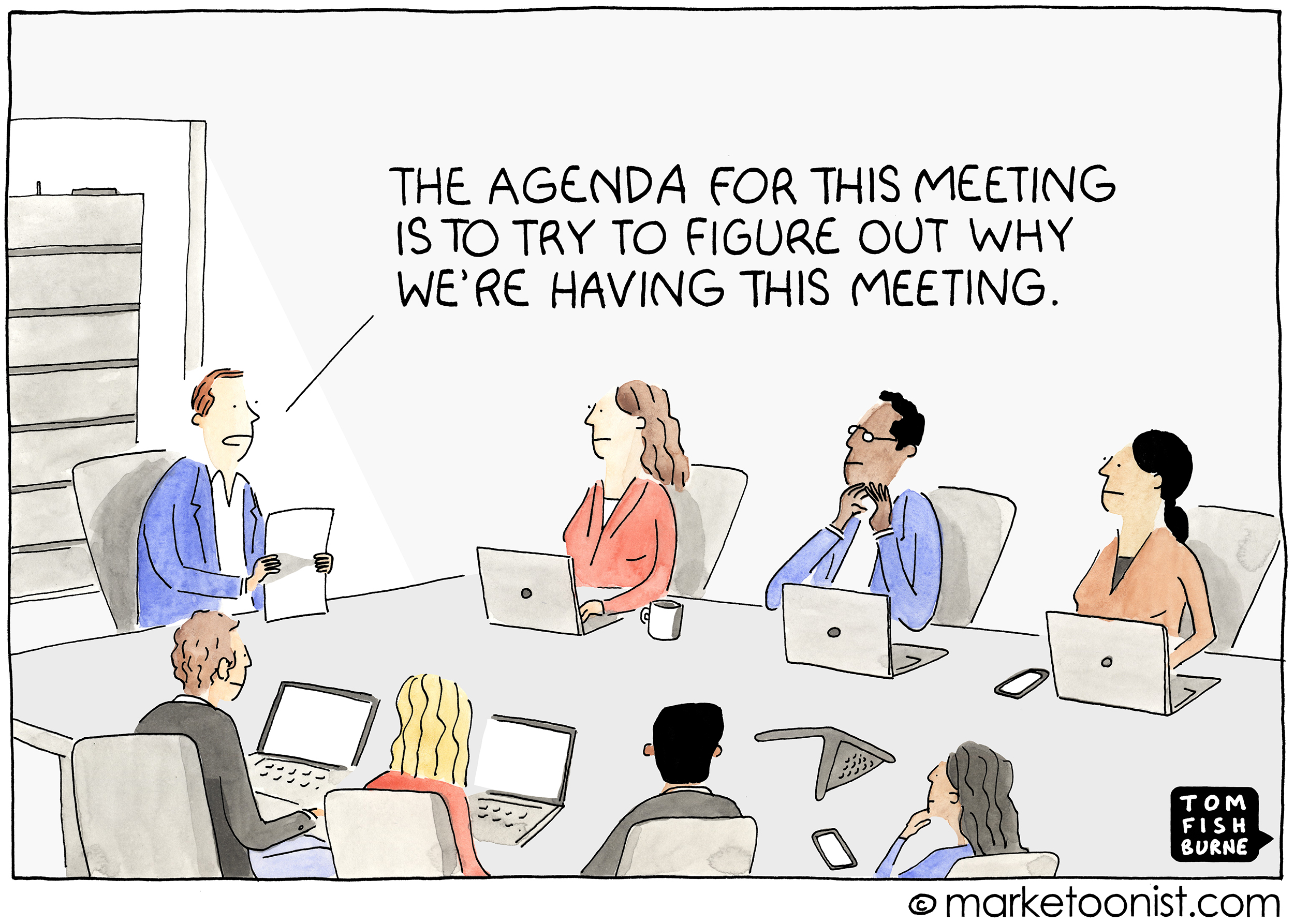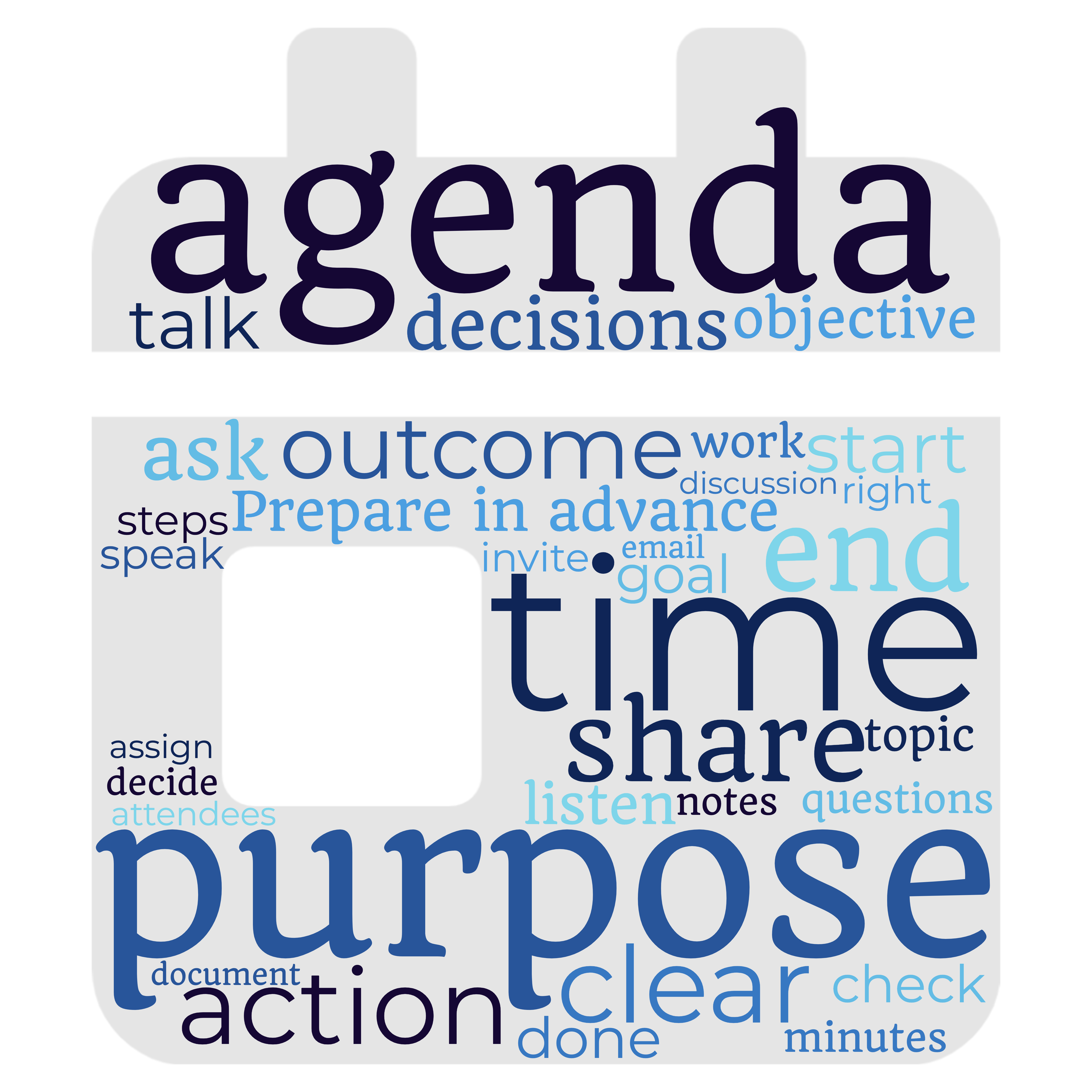It’s Time to Talk About Your Meetings. Here’s How to Get Started.
“How can we reduce the time we’re spending in meetings?”
I used to love it when clients asked me this, because wow – what a softball! This is easy math. To reduce time wasted in unproductive meetings, you can:
- Cancel meetings.
Look for any meeting that lacks a clear purpose or goals, and get rid of it. - Shorten meetings.
Whack 10 minutes off of every recurring meeting on your calendar, and stick to the new time limit. - Invite fewer people.
Eliminate meeting time for those people, who probably have better things to do anyway. - Assign a timekeeper.
This increases your team’s awareness of time passing in the meeting and your odds of ending on time or early.
Here’s a quicky video summing up these easy-math tips.
But do these simple answers actually help the smart professionals asking this question?
No.
Of course not, because this isn’t really a math question.
This is a question about how to change a team’s meeting culture.
The real questions sound more like this. How do I reduce time in meetings…
- without losing momentum on a project?
- when that’s the only time I get to see my favorite co-worker?
- without upsetting my boss?
- when that’s the only way I find out what my employees are really doing?
- without upsetting someone on my team who actually likes that meeting?
- when I don’t have time to plan?
- without leaving people out who should be included?
- when we’ve been sharing this super fancy PowerPoint for years and even though it takes a lot of time to update and review, we’ve grown used to it and I don’t know what else to do?
- without rushing an important conversation?
- when it doesn’t feel right to label any of that time as a waste because sometimes something really valuable comes up?
- when I realize that all I do is meetings, so then what?
These aren’t math questions. They’re culture questions.
Why Meeting Culture Matters
Your meeting culture shows up as:
- Topics: is it safe and normal to talk about what your team is doing in meetings? Are there taboo subjects? People who won’t receive feedback? Opportunities for candor?
- Values: is everyone is expected to share power, follow up on assignments, stay on time? Are you kind to one another? Do you embrace constructive conflict? Are meetings fun?
- Engagement: are meetings a team sport, or are they a drudgery that people use as time to multitask?
- Alignment: do people share information openly, or hoard it in silos? Are you using techniques to work through problems towards common goals, or spending time in battle with other teams?
- Inclusion: does everyone invited provide input? Does everyone’s input receive fair consideration? Who’s invited? Can they opt-out when they need to focus on other things?
This underlying meeting culture sets the context for your meeting success. Some groups have a culture where no one feels like they can suggest or experiment with better ways of meeting, and their meetings never get better. Some groups have a non-nonsense, efficiency-first culture, which keeps meetings short but may also make it hard for teams to create strong relationships. And some groups have meeting cultures that prioritize relationship quality so much that they have trouble holding each other accountable.
The structure, aliveness, deadness, whisper or shout of a meeting teaches and persuades us more about the culture of our workplace than all the speeches about core values and the new culture we are striving for…
What we call meetings are critical cultural passages that create an opportunity for employee engagement or disengagement.
-Peter Block, in the foreword to Terms of Engagement: New Ways of Leading and Changing Organizations
Whatever your current meeting culture might be, sticking with it is a choice. The key to higher levels of meeting performance is to make your choices explicit.
The tragedy here is that most teams never talk about their meeting culture, except to complain. That complaint turns into the question, “How can we reduce time spent in meetings?”
The answers to all of the hard questions behind this easy question start the same way.
You need to talk with your team about your meetings.

The Conversations That Lead to Better Meeting Performance
Some companies run consistently effective meetings every day. Never once has this success been achieved by accident.
In every case, organizations enjoying great meetings designed those meetings. They talk about their meetings. They make explicit agreements about what is and is not acceptable. They create plans for running their meetings. They train, and they practice their meeting skills.
Over the past decade, we’ve investigated what it takes for teams to run successful meetings every day. You can see our findings in the Meeting Performance Maturity Model. Teams with the best performance put more focus on ensuring their meetings are effective and strategically aligned to their business goals.
The maturity model documents the practices we can observe when we visit a company. These practices, however, are just the easy-to-spot evidence that reveals whether a group talks about their meetings and works together to make them better.
Take a look at this table to see the kind of explicit agreements teams make about their meetings at each level of performance maturity.
| Level | Name | Description |
|---|---|---|
| 1 | Individual | There are no agreements. Meeting success is dependent on the preferences and abilities of individual meeting leaders. |
| 2 | Professional | The organization agrees on basic guidelines or norms for all meetings. Meeting leaders take responsibility for seeing that meetings adhere to these guidelines. |
| 3 | Effective | Teams across the organization agree on processes for running their meetings. Meeting processes are defined and implemented to achieve specific outcomes for each business unit. |
| 4 | Systematized | Meeting processes are integrated and harmonized across the organization. The organization agrees on shared systems so people working across departments or moving from team to team know what to expect. |
| 5 | Optimized/World Class | Meeting practices embed the organization’s values and strategic priorities. People regularly talk about how to improve meetings, practice new meeting skills, and train everyone to succeed in their meeting culture. |
If you find these performance levels fascinating and want to learn more, take the free survey. This survey asks you about your team’s practices in the five focus areas of meeting performance (1. Meeting Design, 2. Meeting Skills, 3. Stakeholder Satisfaction, 4. Facilities, Technology, and Resources, and 5. Cultural Ownership). Complete it to get a detailed report of the practices your team agrees on today and those that you have yet to master.
Then, schedule time to talk about your meeting performance as a team.
How to Get the Conversation Started
I recommend starting this conversation in the same way we begin projects with a new client.
Gather real data!
Everyone on your team should create an inventory of all the meetings they attended in a two-week period. For each meeting, they’ll capture the meeting name, how long it took, how many people were involved, and more.
This will feel like work. It is work. Isn’t that fabulous?
You’ve already spent days/months/years throwing around generalized theories and complaints. The time for pontification has passed! Won’t it be wonderful to work with tangible data that you can use to inform meaningful changes?
Every time I have a client complete this exercise, the conversation in their team changes. Their meeting overload isn’t just a theory – it’s real! Their challenge with too many people sitting passively in meetings – look how much that’s costing us! That one guy who says meetings are killing his productivity – why, he rarely meets at all!
Real data is the bomb.
Then, once your team has the data, start talking.
- What do you see? What new patterns are you noticing?
- What do you think this means? What’s working here, and what needs to be improved?
- Now, what will you agree to do going forward?
 Discussion Guide: Create a Team Plan for Better Meetings
Discussion Guide: Create a Team Plan for Better Meetings
Teams run this session to agree on plans for improving their meeting practice.
By the end of this discussion, your team will have a shared understanding of meeting success, a one-month plan for making changes to meetings, a defined list of next steps, and much more!
Tool: Coda template for collecting meeting data, analyzing it, and facilitating the discussion
I’m thrilled to share this Coda template with you.
Review your meeting performance and drive change
The Coda team gets meeting performance. They design their meetings. They talk about how meetings work. They review their meetings regularly to see how they can make them better. When it comes to meeting performance, they’ve got it going on.
And, they’ve helped me build a template you can use with your team. It will help you collect and analyze meeting data in several interesting ways. It also includes a simplified discussion template for your team’s meeting performance review. Check it out. You can use this template directly in Coda, or review it for ideas.
Then get started. It’s time to have a serious talk about meeting performance with your team. Questions? Insights? Results? Let us know in the comments.
Finally, please get in touch if you’d like our help with your meeting culture transformation. We’d love to work with you.



